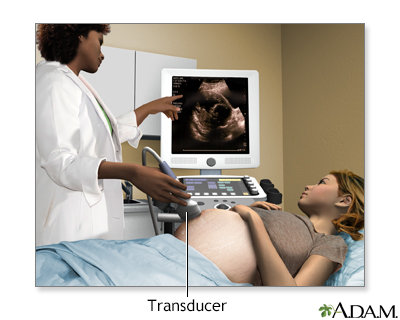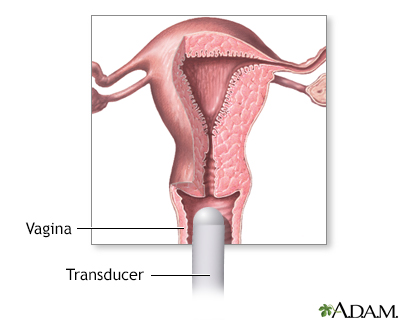Pregnancy SmartSiteTM
Endovaginal ultrasound; Ultrasound - transvaginal; Fibroids - transvaginal ultrasound; Vaginal bleeding - transvaginal ultrasound; Uterine bleeding - transvaginal ultrasound; Menstrual bleeding - transvaginal ultrasound; Infertility - transvaginal ultrasound; Ovarian - transvaginal ultrasound; Abscess - transvaginal ultrasound DefinitionTransvaginal ultrasound is a test used to look at a woman's uterus, ovaries, tubes, cervix, and pelvic area. Transvaginal means across or through the vagina. The ultrasound probe will be placed inside the vagina during the test. How the Test is PerformedYou will lie down on your back on a table with your knees bent. Your feet may be held in stirrups. The ultrasound technician or doctor will introduce an ultrasound probe into your vagina. It may be mildly uncomfortable, but will not hurt. The probe is covered with a condom and a gel.
In some cases, a special transvaginal ultrasound method called saline infusion sonography (SIS) may be needed to more clearly view the uterus. How to Prepare for the TestYou will be asked to undress, usually from the waist down. A transvaginal ultrasound is done with your bladder empty or partly filled. How the Test will FeelIn most cases, there is no pain. Some women may have mild discomfort from the pressure of the probe. Only a small part of the probe is placed into the vagina. Why the Test is PerformedTransvaginal ultrasound may be done for the following problems:
This ultrasound is also used during pregnancy. Normal ResultsThe pelvic structures or fetus is normal. What Abnormal Results MeanAn abnormal result may be due to many conditions. Some problems that may be seen include:
RisksThere are no known harmful effects of transvaginal ultrasound on humans. Unlike traditional x-rays, there is no radiation exposure with this test. ReferencesDolan MS, Hill CC, Valea FA. Benign gynecologic lesions: vulva, vagina, cervix, uterus, oviduct, ovary, ultrasound imaging of pelvic structures. In: Gershenson DM, Lentz GM, Valea FA, Lobo RA, eds. Comprehensive Gynecology. 8th ed. Philadelphia, PA: Elsevier; 2022:chap 18. Hur HC, Lobo RA. Ectopic pregnancy: etiology, pathology, diagnosis, management, fertility prognosis. In: Gershenson DM, Lentz GM, Valea FA, Lobo RA, eds. Comprehensive Gynecology. 8th ed. Philadelphia, PA: Elsevier; 2022:chap 17. Kelly CM. Ectopic pregnancy. In: Kellerman RD, Rakel DP, Heidelbaugh JJ, Lee EM, eds. Conn's Current Therapy 2024. Philadelphia, PA: Elsevier; 2024:1288-1291. Wei PK, Savicke AM, Levine D. The uterus. In: Rumack CM, Levine D, eds. Diagnostic Ultrasound. 6th ed. Philadelphia, PA: Elsevier; 2024:chap 28. | |
| |
Review Date: 4/16/2024 Reviewed By: John D. Jacobson, MD, Professor Emeritus, Department of Obstetrics and Gynecology, Loma Linda University School of Medicine, Loma Linda, CA. Also reviewed by David C. Dugdale, MD, Medical Director, Brenda Conaway, Editorial Director, and the A.D.A.M. Editorial team. The information provided herein should not be used during any medical emergency or for the diagnosis or treatment of any medical condition. A licensed medical professional should be consulted for diagnosis and treatment of any and all medical conditions. Links to other sites are provided for information only -- they do not constitute endorsements of those other sites. No warranty of any kind, either expressed or implied, is made as to the accuracy, reliability, timeliness, or correctness of any translations made by a third-party service of the information provided herein into any other language. © 1997- A.D.A.M., a business unit of Ebix, Inc. Any duplication or distribution of the information contained herein is strictly prohibited. | |

 Ultrasound in preg...
Ultrasound in preg... Female reproductiv...
Female reproductiv... Uterus
Uterus Transvaginal ultra...
Transvaginal ultra...
